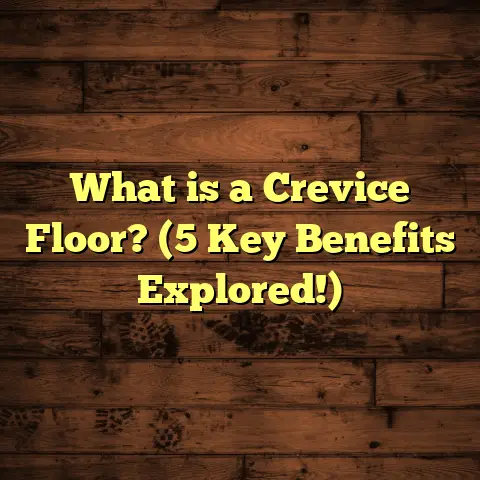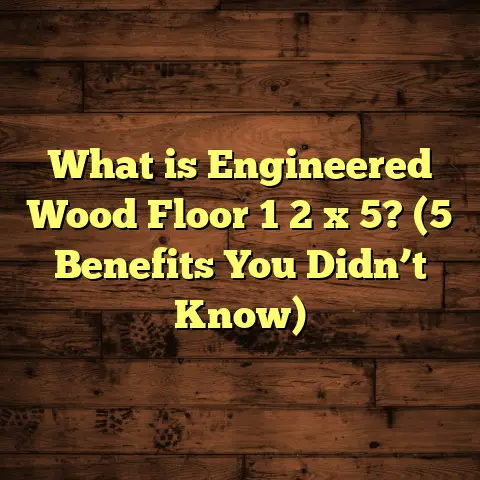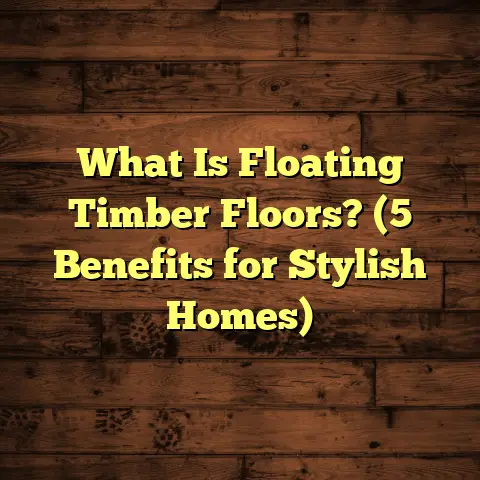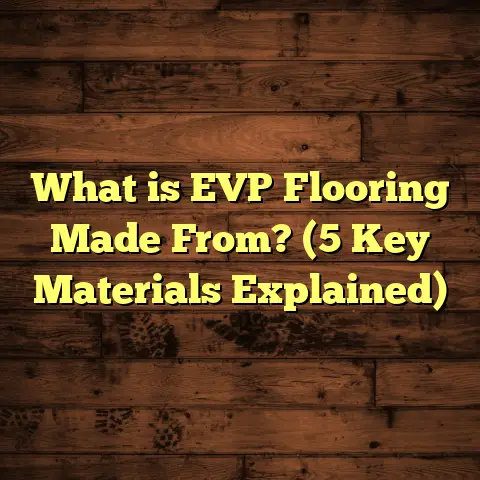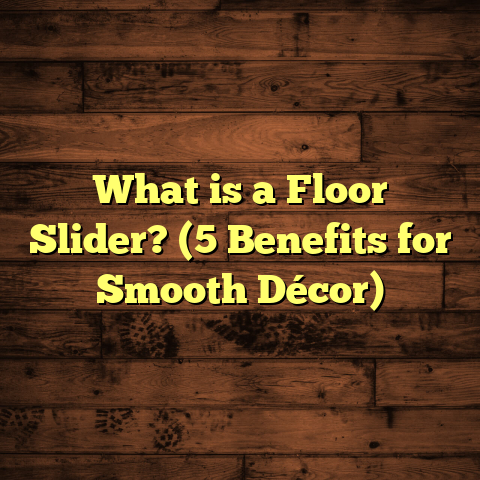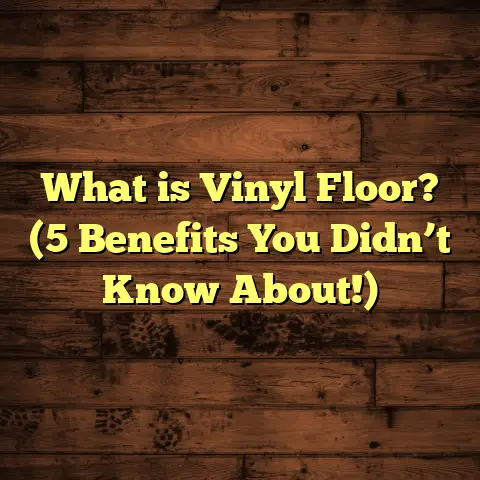What is HPL Flooring? (5 Reasons It’s a Game-Changer!)
When I think about flooring for a room, I always start with the specific needs of that space. What’s going to happen there? Will it be a high-traffic area like a hallway or kitchen, where spills and wear are common? Or is it a cozy bedroom where softness and warmth matter most? Over the years, I’ve installed many types of floors in all kinds of rooms, and one material that has consistently impressed me is HPL flooring.
What is HPL Flooring?
HPL stands for High-Pressure Laminate. It’s a type of flooring made by compressing multiple layers of kraft paper saturated with resin under very high heat and pressure. The resulting product is a dense, durable board with a decorative surface layer that can mimic wood, stone, tile, or other natural materials.
The top layer is coated with a melamine resin that gives it scratch resistance and protects against stains and wear. Beneath that is the core layer, which adds strength and stability.
I often explain HPL flooring to clients as an advanced cousin of traditional laminate flooring but with higher durability and moisture resistance. While classic laminate uses a similar layering concept, HPL’s manufacturing process compresses the layers more tightly — hence the “high-pressure” name — making it tougher and more stable.
This flooring can be installed in residential homes as well as commercial spaces, thanks to its resilience. I’ve seen it hold up to heavy foot traffic in offices and retail stores without showing wear, which is something many other laminates can’t claim.
How I Came Across HPL Flooring
When I first started as a flooring contractor over a decade ago, hardwood was my go-to recommendation. It’s beautiful and timeless but comes with some serious drawbacks: cost, maintenance, and sensitivity to moisture. I also experimented with vinyl plank flooring since it’s waterproof and budget-friendly but often lacked the warmth or authentic look clients wanted.
Laminate flooring was popular too because it was cheap and easy to install, but I quickly noticed its limitations in moisture-prone areas. It swelled or warped when exposed to water and sometimes felt hollow underfoot.
That’s when I discovered HPL flooring through a supplier who pushed it as a next-gen laminate alternative. Skeptical at first, I decided to test it out in my own home’s kitchen renovation. It was affordable, had a wood-look finish that fooled even my neighbors, and after two years of kitchen chaos — kids dropping food, spills, dropped pans — the floor looked as good as day one.
Since then, I’ve installed it in many projects: kitchens, basements, commercial offices, even boutique stores. Each time, it proved its worth in resilience and style.
Why Room-Specific Needs Matter in Flooring
Before choosing flooring materials, I always ask myself: What will this room really see? The demands differ dramatically depending on location and use.
- Kitchen: Expect spills, dropped knives, heavy appliances moving around.
- Bathroom: Constant moisture exposure requires waterproof or water-resistant flooring.
- Living Room: Comfort underfoot and aesthetics are priorities.
- Basement: Often damp or humid; flooring must resist swelling.
- Entryways: Heavy foot traffic and dirt tracking call for durable surfaces.
The wrong choice can lead to costly repairs down the road. For example, hardwood in a basement might warp, while vinyl in a living room might feel cheap and cold.
That’s why understanding what HPL offers makes it easier to decide if it fits your space.
1. Durability: Built to Withstand Life’s Bumps
One reason HPL flooring stands out is its durability. The high-pressure manufacturing process creates a dense core that resists dents and warping better than traditional laminate.
The protective top layer made from melamine resin is designed to withstand scratches from furniture legs, pet claws, shoes—you name it.
In testing labs, some HPL products score between AC4 to AC6 on the Abrasion Criteria scale (AC rating measures how much wear a floor can handle). Regular laminate floors often max out at AC3 or AC4.
What does this mean practically? A floor rated AC5 or AC6 can handle commercial traffic like busy retail environments or heavy household use without looking worn after years.
I remember installing HPL in a local café with lots of foot traffic daily—customers walking in heels and baristas moving heavy carts. Even after one year, the floor showed minimal signs of wear compared to the previous vinyl floors they had installed.
2. Moisture Resistance: Going Beyond Laminate
Moisture is one of the biggest enemies of many floors. Hardwood swells when wet. Laminate often peels or bubbles when exposed to water.
HPL flooring’s core layer is denser than regular laminate and often includes water-resistant treatments or sealants around edges that reduce water absorption.
While it’s not 100% waterproof like some specialized vinyl products (Luxury Vinyl Planks), HPL tolerates accidental spills and humidity far better than traditional laminate.
In one basement laundry room project I worked on, the client wanted an affordable yet moisture-resistant solution. We installed HPL flooring with extra edge sealing. Over six months of regular washer/dryer use and occasional water splashes, the floor never buckled or warped.
This quality makes HPL ideal for kitchens, entryways, basements—areas where spills or humidity are common but you still want an attractive wood or stone look.
3. Aesthetic Appeal: Looks That Impress
When I first showed my clients samples of HPL flooring with textured wood grain finishes or natural stone patterns, they were often surprised at how realistic they looked.
Advances in printing technology allow manufacturers to replicate wood knots, grain patterns, stone veining with remarkable detail.
But what really sells me on HPL is how the surface feels underfoot. Embossed textures add depth you don’t get with flat vinyl or laminate surfaces.
For example, one client wanted an oak-look floor for their living room but couldn’t afford hardwood. We chose an HPL product with a multi-layered grain texture that captured light beautifully. Guests kept asking if it was real wood!
This brings style into budget-friendly territory without compromising on warmth or character.
4. Installation: Fast, Clean & DIY Friendly
A big bonus for me—and many homeowners—is how easy HPL flooring is to install. Most products use click-lock systems similar to laminate floors.
I’ve installed several rooms myself within a day—no glue or nails required—and cleanup was quick since no messy adhesives were involved.
This ease means you can save both money on labor costs and time waiting for installation to finish.
Unlike tile or hardwood that need complex subfloor prep or acclimation times (sometimes several days), HPL is less sensitive to environmental changes due to its compressed core.
That stability reduces the chances of gaps or buckling after installation—a common problem I’ve seen with cheaper laminate products.
5. Sustainability: Eco-Friendly Choices Are Growing
More clients ask about sustainability now than ever before. Fortunately, many HPL manufacturers are stepping up by using recycled materials in their core layers and sourcing papers responsibly.
Some brands also produce low-VOC finishes that improve indoor air quality—a big plus for families concerned about health impacts from building materials.
I recently worked on a project where the client demanded eco-conscious products for their new home office. We selected an HPL product certified by independent environmental groups for responsible forestry practices and chemical safety.
Knowing that stylish floors can also align with greener building practices makes me confident recommending these options more often.
Deeper Look Into Technical Aspects of HPL Flooring
Composition & Manufacturing Process
If you’re curious about what makes HPL unique on a technical level:
- The core consists of several layers (typically 5-7 sheets) of kraft paper impregnated with phenolic resin.
- These layers are stacked and pressed at pressures ranging from 1,000 psi up to 1,500 psi under temperatures of about 150°C (300°F).
- The top decorative layer is printed paper coated with melamine resin and aluminum oxide particles for hardness.
- This process forms a compact board typically 6-12 mm thick depending on product specs.
This compression increases density dramatically compared to standard laminate (which might be pressed at lower pressures).
Abrasion Resistance & Impact Strength
HPL flooring scores high marks on abrasion tests due to its tough wear layer:
- Resistant to scratches from furniture moving across.
- Handles impact from dropped objects better than vinyl or laminate.
- Wears evenly over time without peeling or bubbling common in some laminates.
Moisture & Heat Tolerance
While not fully waterproof:
- HPL tolerates short-term water exposure without swelling.
- Edge banding/sealing methods reduce moisture infiltration between planks.
- Heat resistance makes it suitable near radiators or underfloor heating systems (check product-specific limits).
Case Study: Commercial Application in a Retail Space
I worked with a mid-sized boutique store owner who needed durable flooring that looked upscale but fit within budget constraints.
We recommended an HPL floor with a classic walnut finish embossed with natural grain texture.
Over 12 months:
- Foot traffic averaged over 300 customers daily.
- Spills from drinks were cleaned immediately but occasionally lingered.
- Floor retained original color without fading under sunlight exposure from large windows.
- No scratches or dents appeared despite moving heavy racks weekly.
The client was thrilled because the floor offered the look of hardwood without its usual upkeep headaches.
Comparing HPL Flooring With Other Popular Materials
Here’s how I weigh options based on my experience:
| Flooring Type | Durability | Moisture Resistance | Installation Ease | Cost Range | Aesthetic Appeal |
|---|---|---|---|---|---|
| Hardwood | High | Low | Medium | $$$$ | Very High |
| Laminate | Medium | Low | Easy | $ | Medium |
| Vinyl (LVP) | High | Very High | Easy | $$ – $$$ | Medium |
| Tile | Very High | Very High | Difficult | $$ – $$$ | High |
| HPL Flooring | High | Medium – High | Easy | $$ – $$$ | High |
Hardwood floors are gorgeous but expensive and tricky around moisture-prone zones. Laminate may be affordable but lacks longevity in wet areas. Vinyl offers waterproof qualities but sometimes misses natural texture appeal.
HPL hits a sweet spot: strong enough for busy homes/commercial spaces; moisture resistant enough for kitchens/basements; visually appealing; easy to install; and priced reasonably between laminate and hardwood.
Tips From My Experience Installing HPL Flooring
- Choose Quality Brands: Not all HPL products are equal—higher-priced options usually offer better core density and wear layers.
- Prepare Your Subfloor: Make sure your subfloor is clean, level, and dry for best results.
- Acclimate Before Installation: Although less sensitive than wood floors, letting planks sit in the room temperature for 48 hours helps prevent minor expansion issues.
- Seal Edges in Wet Areas: Use water-resistant sealant around edges/kitchen islands if spills are likely.
- Use Proper Underlayment: Choose underlayment recommended by manufacturer for soundproofing and added comfort.
- Avoid Excess Water Cleaning: Use damp mops rather than soaking wet mops during maintenance.
- Furniture Pads Prevent Scratches: Use pads under heavy furniture legs especially if you move them regularly.
- Regular Cleaning Keeps Floors Looking New: Sweep/vacuum regularly to avoid dirt buildup scratching the surface.
Frequently Asked Questions About HPL Flooring
Q: Can HPL flooring be installed over radiant heating?
A: Yes! Many HPL floors tolerate underfloor heating as long as temperature limits set by manufacturers aren’t exceeded (usually max 27°C/80°F).
Q: Is HPL good for pets?
A: Definitely! Its scratch-resistant surface holds up well against pet claws better than many laminates or vinyls.
Q: How long does HPL flooring last?
A: With proper care, you can expect 15-25 years depending on traffic levels — comparable to mid-range hardwoods.
Q: Can I install HPL flooring myself?
A: Yes! The click-lock system makes installation straightforward for DIYers confident with basic tools.
Wrapping Up My Take on HPL Flooring
Over many years working hands-on installing various types of floors across homes and businesses, I’ve come to appreciate how versatile and reliable HPL flooring is.
It balances durability, moisture resistance, aesthetic appeal, ease of installation, and cost better than many alternatives I’ve used or recommended.
If you’re looking for floors that stand up to real life—spills in kitchens, muddy boots at entryways, constant foot traffic—and want something stylish without breaking your budget, give HPL serious thought.
Got questions about your specific project or need help picking out materials? I’m here to share what I’ve learned firsthand so you get floors you love every single day!
